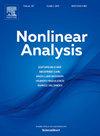不利区域对具有Allee效应的物种入侵过程的影响
IF 1.3
2区 数学
Q1 MATHEMATICS
引用次数: 0
摘要
为了模拟具有不利区域的环境中的传播现象,我们考虑了不利区域内负增长速率和不利区域外双稳态反应的反应扩散方程。我们严格地研究了不利区域宽度L对解传播的影响。结果表明,存在一个仅依赖于反应项的临界值L *,使得当L<;L *时,对于任何解都发生扩散,即它成功地通过了不利区域并在该区域建立了较小的缺陷;当L=L *时,只对初始种群大的种群发生扩散性,而对初始数据小的种群发生残差性,即解收敛于一个小的稳态;当L>;L *时,我们得到一个三分法结果:对于初始种群大/小的物种,会发生扩展/残差,但对于初始数据中等的物种,它也不能通过区域,并收敛到过渡稳态。本文章由计算机程序翻译,如有差异,请以英文原文为准。
The effect of an unfavorable region on the invasion process of a species with Allee effect
To model a propagating phenomena through the environment with an unfavorable region, we consider a reaction–diffusion equation with negative growth rate in the unfavorable region and bistable reaction outside of it. We study rigorously the influence of , the width of the unfavorable region, on the propagation of solutions. It turns out that there exists a critical value depending only on the reaction term such that, when , spreading happens for any solution in the sense that it passes through the unfavorable region successfully and establish with minor defect in the region; when , spreading happens only for a species with large initial population, while residue happens for a population with small initial data, in the sense that the solution converges to a small steady state; when we have a trichotomy result: spreading/residue happens for a species with large/small initial population, but, for a species with medium-sized initial data, it cannot pass through the region either and converges to a transition steady state.
求助全文
通过发布文献求助,成功后即可免费获取论文全文。
去求助
来源期刊
CiteScore
3.30
自引率
0.00%
发文量
265
审稿时长
60 days
期刊介绍:
Nonlinear Analysis focuses on papers that address significant problems in Nonlinear Analysis that have a sustainable and important impact on the development of new directions in the theory as well as potential applications. Review articles on important topics in Nonlinear Analysis are welcome as well. In particular, only papers within the areas of specialization of the Editorial Board Members will be considered. Authors are encouraged to check the areas of expertise of the Editorial Board in order to decide whether or not their papers are appropriate for this journal. The journal aims to apply very high standards in accepting papers for publication.

 求助内容:
求助内容: 应助结果提醒方式:
应助结果提醒方式:


